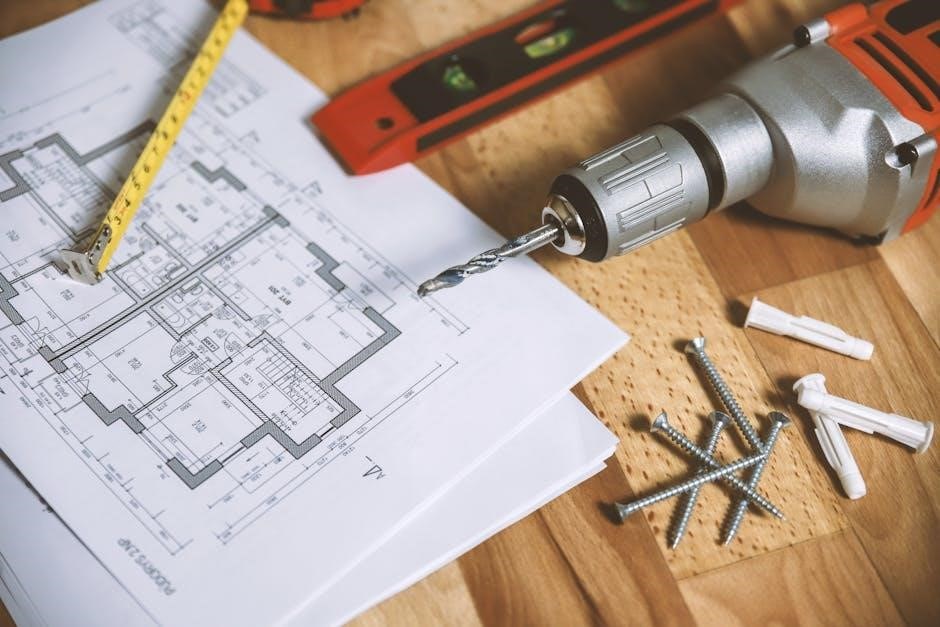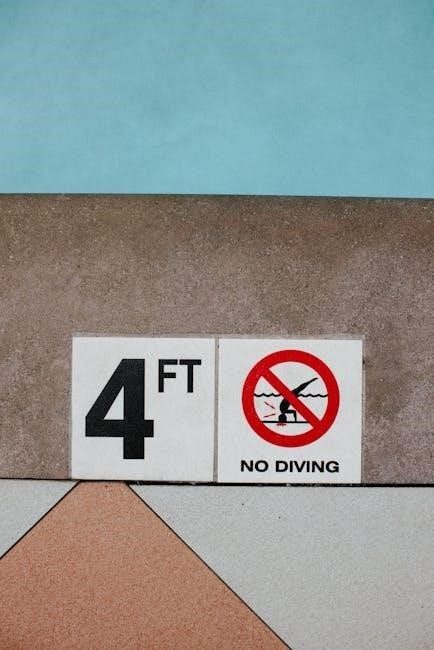An Earthquake Drill Instruction Crossword is an engaging educational tool designed to familiarize participants with critical safety measures during earthquakes. It typically features clues related to key instructions like DUCKANDCOVER and DROP, COVER, HOLD ON. This interactive format transforms complex emergency preparedness information into a fun and challenging learning experience. By solving the crossword, individuals reinforce their knowledge of essential earthquake drill instructions, ensuring better preparedness for real-life scenarios.
1.1 What is an Earthquake Drill Instruction Crossword?
An Earthquake Drill Instruction Crossword is an interactive learning tool designed to educate individuals about essential safety measures during earthquakes. It combines puzzle-solving with emergency preparedness, featuring clues and answers that highlight key instructions like DUCKANDCOVER, DROP, COVER, HOLD ON, and other critical safety phrases. The crossword typically includes terms such as SHELTER, EVACUATE, and SECURE, which are vital for navigating earthquake scenarios. By solving the crossword, participants engage with these terms in a fun and challenging way, reinforcing their memory of the steps needed during an earthquake. This format caters to diverse learning styles, making it an effective resource for both individuals and groups. The crossword’s structured design ensures clarity, while its content fosters awareness and readiness, transforming complex safety information into an accessible and engaging experience.
1.2 Significance of Earthquake Preparedness
Earthquake preparedness is crucial for minimizing risks and ensuring safety during seismic events. It involves understanding and implementing safety measures, such as the DUCKANDCOVER technique, to protect individuals from harm. Preparedness fosters quick and informed actions, reducing the likelihood of injury and property damage. Regular drills and practice are essential, as earthquakes strike without warning, leaving little time for decision-making. By familiarizing oneself with safety protocols, individuals can act swiftly and confidently, enhancing their chances of survival. Furthermore, preparedness extends beyond personal safety, contributing to community resilience and faster recovery efforts. Education and awareness are key components, as they empower people to take proactive steps in safeguarding themselves and others. The Earthquake Drill Instruction Crossword serves as a valuable tool in this process, reinforcing critical instructions in an engaging and memorable way. Ultimately, preparedness is a lifesaving practice that ensures individuals are equipped to handle the unpredictability of earthquakes effectively.

Educational Value of the Crossword
The Earthquake Drill Instruction Crossword educates participants about critical safety measures through interactive clues like DUCKANDCOVER. It promotes engagement, caters to diverse learning styles, and enhances problem-solving skills, making emergency preparedness both fun and effective.

2;1 Engaging Learning Tool
The Earthquake Drill Instruction Crossword is a dynamic and interactive way to educate individuals about earthquake preparedness. By incorporating clues related to safety measures, such as DUCKANDCOVER and DROP, COVER, HOLD ON, it transforms complex information into an enjoyable challenge. This tool caters to diverse learning styles, engaging visual, auditory, and kinesthetic learners alike. The puzzle’s structure encourages active participation, as solvers must decode hints and fill in the grid, fostering problem-solving skills and critical thinking. Its interactivity makes learning fun, which enhances retention and motivation. For instance, clues like “Practice for a seismic event” or “Safety position during shaking” prompt users to think creatively while reinforcing essential safety protocols. This approach ensures that participants not only gain knowledge but also develop a deeper understanding of earthquake preparedness in an engaging and memorable way. The crossword’s ability to balance education with entertainment makes it a valuable resource for both individual and group learning environments.
2.2 Promoting Safety Awareness
The Earthquake Drill Instruction Crossword plays a vital role in fostering safety awareness by integrating key emergency preparedness terms and phrases. By solving clues related to earthquake drills, participants gain familiarity with critical safety instructions such as DUCKANDCOVER and DROP, COVER, HOLD ON. This interactive approach ensures that safety information is not only learned but also retained through repetition and engagement. The crossword’s design makes complex safety protocols accessible and memorable, encouraging individuals to think proactively about their actions during an earthquake. Regular exposure to these terms reinforces their importance, ensuring that participants are better prepared to respond effectively in real-life scenarios. Moreover, the crossword serves as a practical tool for communities and educators to promote a culture of preparedness. By prioritizing safety awareness, the crossword contributes to the collective ability to withstand and recover from seismic events, making it an invaluable resource for disaster preparedness education.

Solving Strategies for Earthquake Drill Instruction Crossword
Solving the crossword involves breaking down clues into key components like “earthquake” and “instruction,” often leading to answers like DUCKANDCOVER. Using crossword solver tools can also help identify these terms efficiently.
3.1 Breaking Down the Clue
Breaking down the clue is a systematic approach to solving the Earthquake Drill Instruction Crossword. Start by identifying key components of the clue, such as “earthquake” and “instruction,” which often point to specific safety measures. For example, the clue “Earthquake drill instruction” frequently leads to answers like DUCKANDCOVER or DROP, COVER, HOLD ON. These phrases are central to earthquake preparedness and are commonly featured in crosswords due to their relevance. Next, consider the word length and structure, as crosswords often rely on specific patterns. Look for clues that hint at well-known safety phrases or actions, as these are likely to be the answers. Additionally, recognizing common patterns in crossword answers, such as alliteration or familiar sayings, can help narrow down possibilities. By methodically analyzing the clue and its components, solvers can efficiently uncover the correct answer, ensuring a logical and effective solving process.

3.2 Using Crossword Solver Tools
Using crossword solver tools is an efficient way to tackle clues like “Earthquake drill instruction.” These tools allow users to input the clue and the number of letters, providing potential answers. For example, entering “Earthquake drill instruction” with a 12-letter length often yields DUCKANDCOVER as a likely solution. Many solvers also offer pattern matching, helping to narrow down possibilities by matching letters or patterns. Additionally, they often list multiple answers, ranked by relevance, giving solvers options to choose from. This feature is particularly useful for clues with multiple possible solutions, such as DROP, COVER, HOLD ON or SECURE.
Crossword solver tools not only save time but also assist in understanding common crossword patterns. They are especially useful for tricky clues, making the solving process more efficient and enjoyable for both novices and experienced puzzlers alike. By leveraging these tools, solvers can quickly identify the correct answer and deepen their understanding of earthquake drill instructions.

Common Patterns in Crossword Answers
Earthquake drill instruction crosswords often feature answers like DUCKANDCOVER or DROP, COVER, HOLD ON, which are common safety phrases. These answers typically follow specific word lengths and structures, making them easier to identify and solve systematically.
4.1 Word Length and Structure
Earthquake drill instruction crosswords often feature answers with specific word lengths and structures. For example, the clue Earthquake drill instruction frequently points to DUCKANDCOVER, a 12-letter answer that fits neatly into the grid. Other common phrases like DROP, COVER, HOLD ON are shorter but equally structured, making them easier to identify. The crossword’s design often relies on these consistent word lengths to ensure clarity and solvability. Additionally, many safety-related terms, such as SHELTER or EVACUATE, are concise and align with typical crossword answer patterns. The use of action verbs or compound phrases further enhances the puzzle’s educational value, as these terms are both familiar and relevant to earthquake preparedness. By understanding these word length and structure patterns, solvers can more efficiently navigate the crossword, reinforcing their knowledge of critical safety instructions. This systematic approach ensures that the crossword remains both challenging and informative, making it an effective tool for learning and retention.
4.2 Recognizing Safety Phrases

Safety phrases are a cornerstone of earthquake drill instruction crosswords, as they represent the most critical actions to take during an earthquake. Common phrases like DUCKANDCOVER and DROP, COVER, HOLD ON are frequently featured, as they are widely recognized and taught in drills. These phrases are often highlighted in crossword clues, making them easier to identify for solvers familiar with earthquake preparedness. Additionally, terms like SHELTER, EVACUATE, and SECURE are commonly included, as they represent key actions to ensure safety. Crossword constructors often use these phrases because they are concise, memorable, and directly tied to emergency protocols. By incorporating such phrases, the crossword not only tests knowledge but also reinforces the importance of these safety measures. Recognizing these phrases enhances both problem-solving skills and readiness for real-life scenarios, making the crossword a practical tool for education and preparedness. This focus on safety phrases ensures the puzzle remains relevant and impactful for its users.

The DUCKANDCOVER Technique
The DUCKANDCOVER technique is a primary solution in earthquake drill instruction crosswords, emphasizing safety by seeking cover under sturdy furniture and shielding the head and neck from falling debris. This method minimizes exposure to hazards during earthquakes, providing essential protection until the tremors subside.
5.1 Description of the Method
The DUCKANDCOVER technique is a widely taught safety procedure during earthquakes. It involves immediately dropping to the ground, seeking cover under sturdy furniture like a table or desk, and protecting the head and neck from falling debris. This method prioritizes minimizing exposure to hazards such as collapsing structures or heavy objects. The process is straightforward: upon feeling tremors, individuals should quickly identify the nearest safe spot, lower themselves to the ground, and shield their heads with their arms. The goal is to create a protective barrier between the individual and potential dangers. Once the shaking stops, participants should carefully assess their surroundings before evacuating the area. This technique is often highlighted in earthquake drill instruction crosswords as a key answer, reinforcing its importance in emergency preparedness. Its simplicity makes it accessible for all ages, ensuring widespread adoption in drills and real-life scenarios.
5.2 Historical Background
The DUCKANDCOVER technique has a rich history rooted in mid-20th-century emergency preparedness. Initially developed during the Cold War era, it was designed to protect individuals from nuclear fallout. Over time, its application evolved to include earthquake safety, becoming a cornerstone of disaster preparedness worldwide. Schools, communities, and governments widely adopted the method, incorporating it into drills and educational materials. Public campaigns and training programs further popularized the technique, making it a familiar routine for generations. Its enduring relevance lies in its simplicity and effectiveness, providing immediate protection during seismic events. Today, the DUCKANDCOVER method remains a foundational element in earthquake preparedness, with its legacy evident in modern safety protocols and educational tools like the earthquake drill instruction crossword. This historical context underscores its adaptability and continued importance in saving lives during earthquakes.

Earthquake Drills and Their Importance
Earthquake drills are essential for preparing individuals and communities to respond effectively during seismic events. These structured exercises simulate real-life scenarios, teaching participants to identify safe spots, practice safety techniques, and evacuate calmly. Regular drills ensure readiness, reduce panic, and minimize risks during earthquakes, fostering a culture of preparedness and resilience.
6.1 Practical Steps in Earthquake Drills
Earthquake drills involve a series of practical steps to ensure safety and readiness. First, participants identify safe spots such as under sturdy furniture or against interior walls. The DUCKANDCOVER technique is widely practiced, where individuals drop to the ground, seek cover, and protect their heads. Securing heavy objects and ensuring clear escape routes are also critical steps. After the shaking stops, participants assess their surroundings for hazards before evacuating calmly. Regular simulations help reinforce these actions, ensuring quick and informed responses during real earthquakes. These drills also emphasize communication, with alarms or signals used to initiate the exercise. By practicing these steps, individuals and communities build the skills and confidence needed to navigate seismic events effectively, reducing risks and fostering resilience.

6.2 Role of Drills in Reinforcing Safety Instructions
Earthquake drills play a vital role in reinforcing safety instructions by transforming theoretical knowledge into practical application. These exercises simulate real-life scenarios, allowing participants to practice and internalize critical actions like DUCKANDCOVER or DROP, COVER, AND HOLD ON. Regular drills ensure that safety protocols become second nature, reducing panic during actual emergencies. The repetition of these exercises strengthens muscle memory, enabling individuals to act swiftly and correctly. Additionally, drills provide an opportunity to identify and address gaps in preparedness, fostering continuous improvement. The interactive nature of drills, combined with tools like the earthquake drill instruction crossword, enhances engagement and retention of safety information. By reinforcing these instructions, drills empower individuals and communities to respond effectively during earthquakes, ultimately saving lives and minimizing damage. The consistent practice of safety measures through drills ensures that preparedness becomes a deeply ingrained habit, ready to be activated when needed most.

